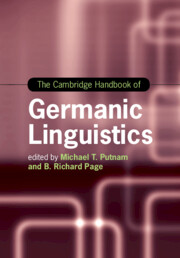Book contents
- The Cambridge Handbook of Germanic Linguistics
- Cambridge Handbooks in Language and Linguistics
- The Cambridge Handbook of Germanic Linguistics
- Copyright page
- Contents
- Figures
- Maps
- Tables
- Contributors
- Acknowledgments
- Germanic Languages
- Part I Phonology
- Part II Morphology and Agreement Systems
- Part III Syntax
- Part IV Semantics and Pragmatics
- Chapter 24 Modality in Germanic
- Chapter 25 Tense and Aspect in Germanic Languages
- Chapter 26 Prepositions and Particles
- Chapter 27 Negative and Positive Polarity Items
- Chapter 28 Grammatical Reflexes of Information Structure in Germanic Languages
- Part V Language Contact and Nonstandard Varieties
- Index
- References
Chapter 27 - Negative and Positive Polarity Items
from Part IV - Semantics and Pragmatics
Published online by Cambridge University Press: 31 March 2020
- The Cambridge Handbook of Germanic Linguistics
- Cambridge Handbooks in Language and Linguistics
- The Cambridge Handbook of Germanic Linguistics
- Copyright page
- Contents
- Figures
- Maps
- Tables
- Contributors
- Acknowledgments
- Germanic Languages
- Part I Phonology
- Part II Morphology and Agreement Systems
- Part III Syntax
- Part IV Semantics and Pragmatics
- Chapter 24 Modality in Germanic
- Chapter 25 Tense and Aspect in Germanic Languages
- Chapter 26 Prepositions and Particles
- Chapter 27 Negative and Positive Polarity Items
- Chapter 28 Grammatical Reflexes of Information Structure in Germanic Languages
- Part V Language Contact and Nonstandard Varieties
- Index
- References
Summary
As many, if not all, other languages, the Germanic languages have expressions that are sensitive to the polarity of the clause in which they occur. Negative polarity items (NPIs) can only occur in clauses that are in some sense negative, whereas positive polarity items (PPIs) can only occur in clauses that are affirmative. This chapter reviews some lines of inquiry on polarity sensitive items that have been developed within the framework of generative grammar. It is shown that syntax, semantics, and pragmatics closely interact in the constraints that govern the distribution of polarity items. Questions addressed include the following: What are the lexical properties of polarity sensitive items? How can the environments in which NPIs can occur and PPIs cannot occur be characterized as natural class? How is the licensing condition to be formulated? Why are polarity items sensitive to the polarity of the context in which they occur?
Keywords
- Type
- Chapter
- Information
- The Cambridge Handbook of Germanic Linguistics , pp. 639 - 660Publisher: Cambridge University PressPrint publication year: 2020
References
- 3
- Cited by



